Finance Report on ARB Corporation: Materiality and Financial Analysis
VerifiedAdded on 2023/06/07
|16
|3018
|194
Report
AI Summary
This finance report provides a comprehensive analysis of ARB Corporation's 2017 annual report, focusing on key financial aspects. The report begins with an executive summary and table of contents, followed by a detailed examination of materiality concerns, adhering to ASA 320 guidelines. Materiality levels are calculated based on revenue, total assets, shareholders' equity, and net profit, with a calculated materiality level of $350,000. Section 2 presents a preliminary analytical review, employing ratio analysis to assess the company's financial performance over several years, including operating margin, return on capital, return on equity, payout ratio, and dividend yield. Comparisons are made with industry averages, highlighting areas of strength and potential improvement. Audit assertions and procedures are also discussed. The final section reviews the cash flow statement, analyzing cash flows from operating activities. The report concludes with a discussion of audit risks and relevant assertions. The report is well-structured, providing a solid foundation for students studying finance and auditing.
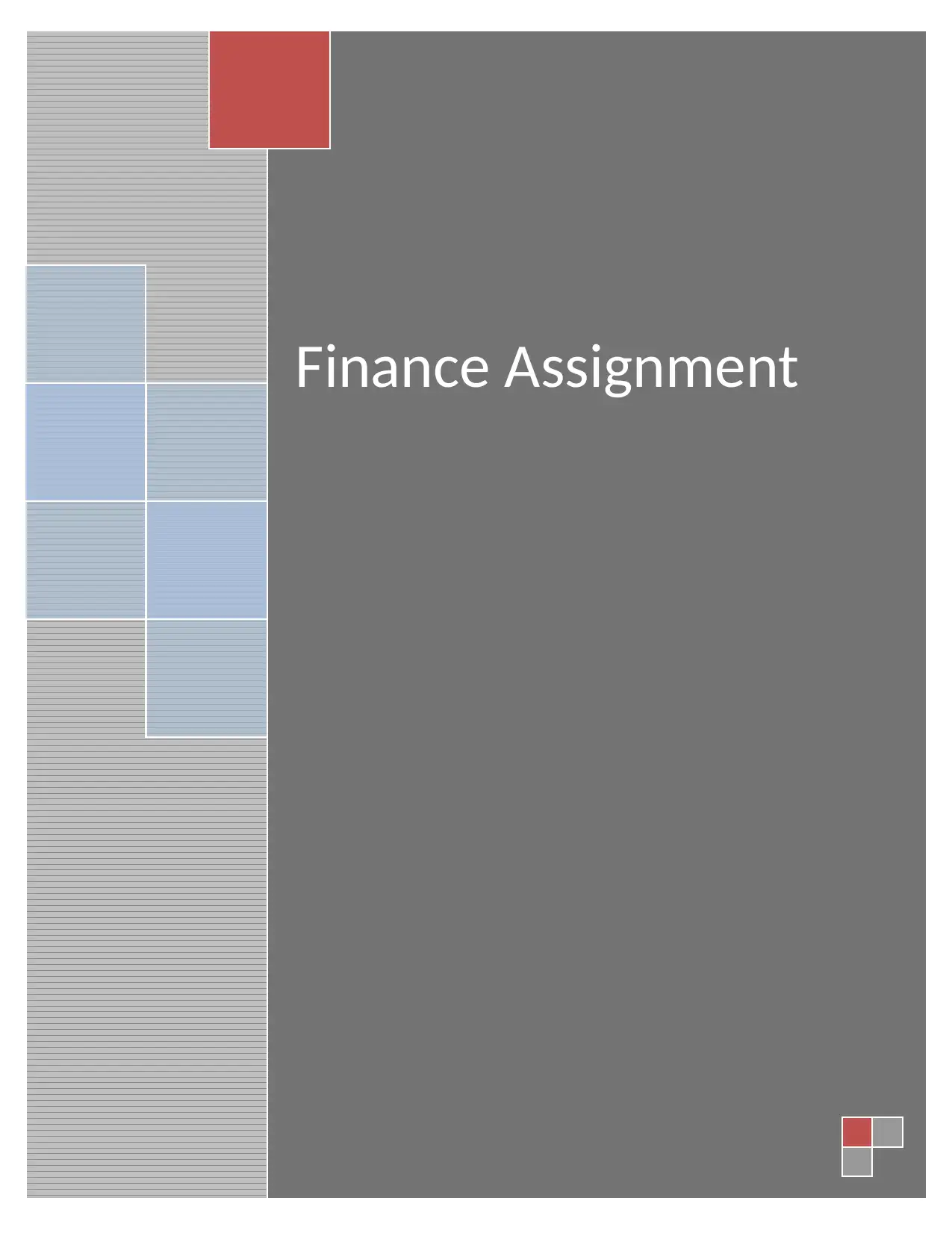
Finance Assignment
Paraphrase This Document
Need a fresh take? Get an instant paraphrase of this document with our AI Paraphraser
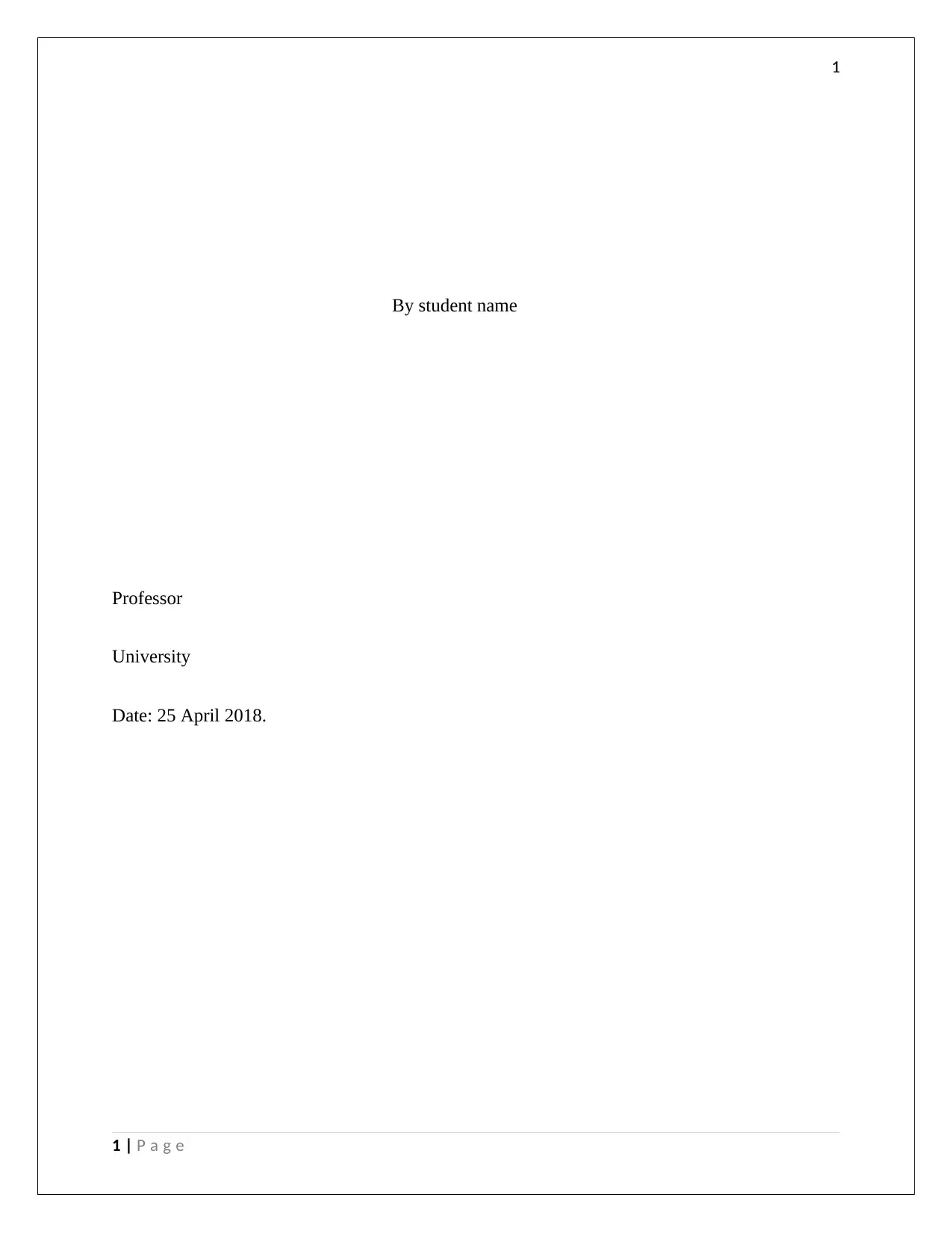
1
By student name
Professor
University
Date: 25 April 2018.
1 | P a g e
By student name
Professor
University
Date: 25 April 2018.
1 | P a g e
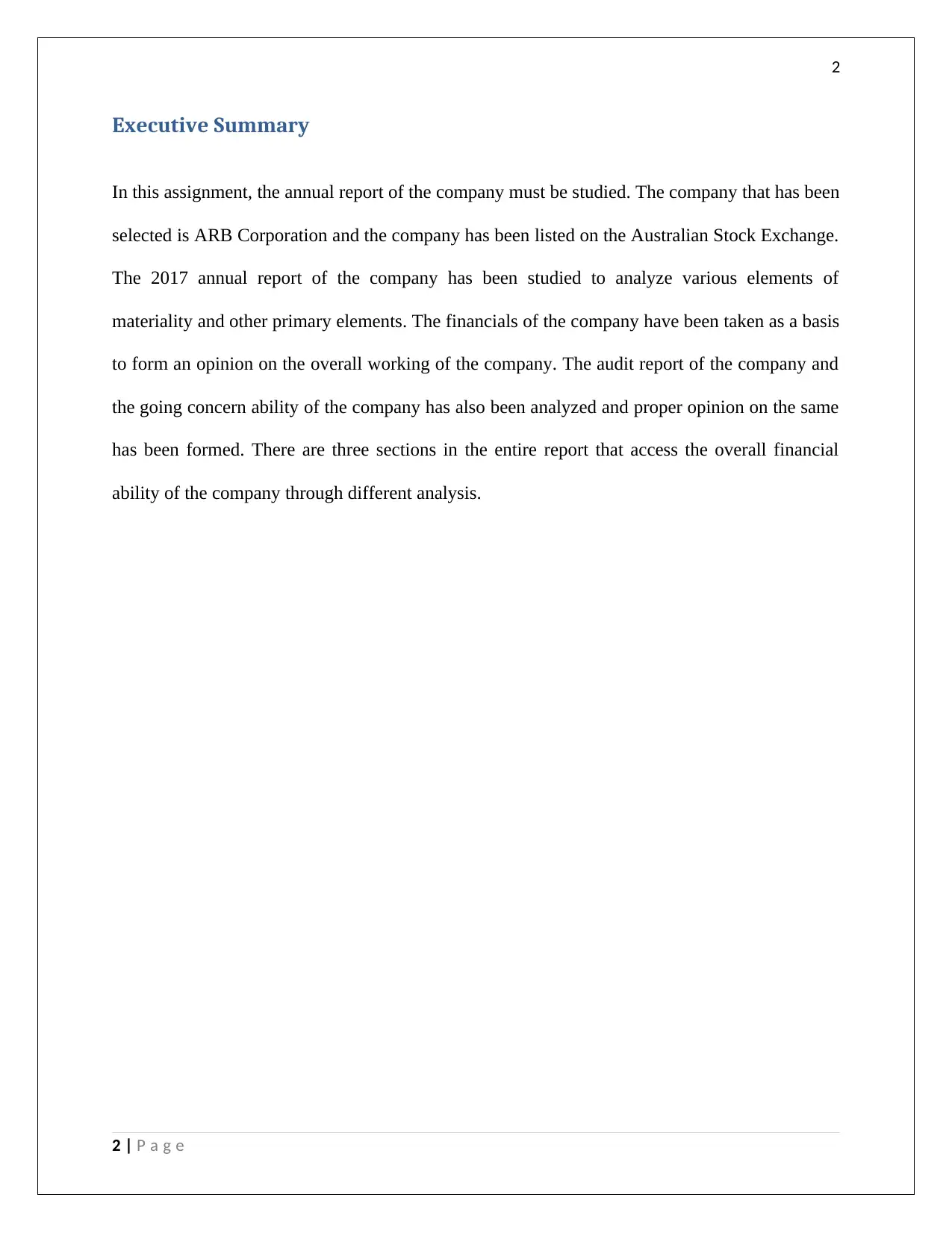
2
Executive Summary
In this assignment, the annual report of the company must be studied. The company that has been
selected is ARB Corporation and the company has been listed on the Australian Stock Exchange.
The 2017 annual report of the company has been studied to analyze various elements of
materiality and other primary elements. The financials of the company have been taken as a basis
to form an opinion on the overall working of the company. The audit report of the company and
the going concern ability of the company has also been analyzed and proper opinion on the same
has been formed. There are three sections in the entire report that access the overall financial
ability of the company through different analysis.
2 | P a g e
Executive Summary
In this assignment, the annual report of the company must be studied. The company that has been
selected is ARB Corporation and the company has been listed on the Australian Stock Exchange.
The 2017 annual report of the company has been studied to analyze various elements of
materiality and other primary elements. The financials of the company have been taken as a basis
to form an opinion on the overall working of the company. The audit report of the company and
the going concern ability of the company has also been analyzed and proper opinion on the same
has been formed. There are three sections in the entire report that access the overall financial
ability of the company through different analysis.
2 | P a g e
⊘ This is a preview!⊘
Do you want full access?
Subscribe today to unlock all pages.

Trusted by 1+ million students worldwide
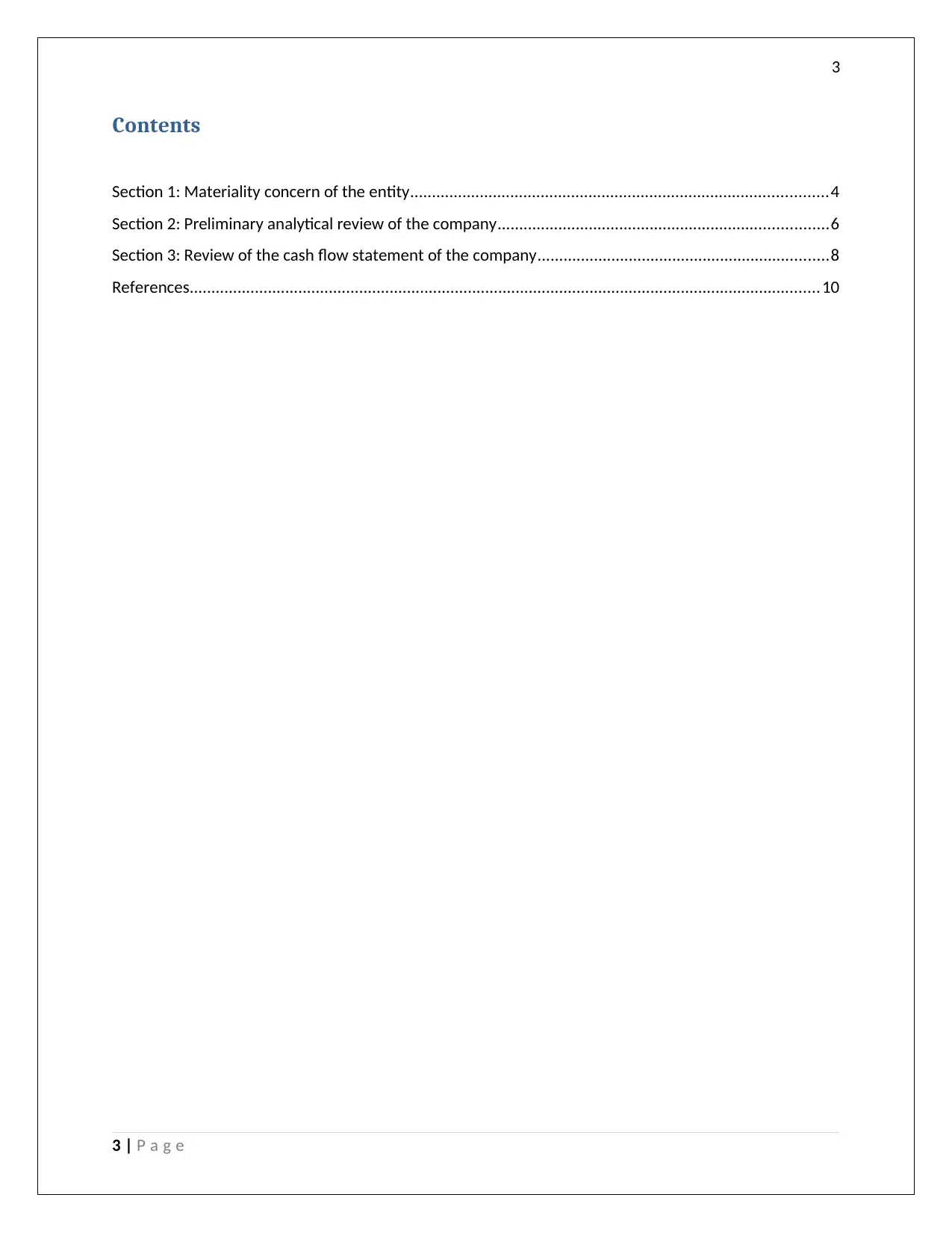
3
Contents
Section 1: Materiality concern of the entity................................................................................................4
Section 2: Preliminary analytical review of the company............................................................................6
Section 3: Review of the cash flow statement of the company...................................................................8
References.................................................................................................................................................10
3 | P a g e
Contents
Section 1: Materiality concern of the entity................................................................................................4
Section 2: Preliminary analytical review of the company............................................................................6
Section 3: Review of the cash flow statement of the company...................................................................8
References.................................................................................................................................................10
3 | P a g e
Paraphrase This Document
Need a fresh take? Get an instant paraphrase of this document with our AI Paraphraser
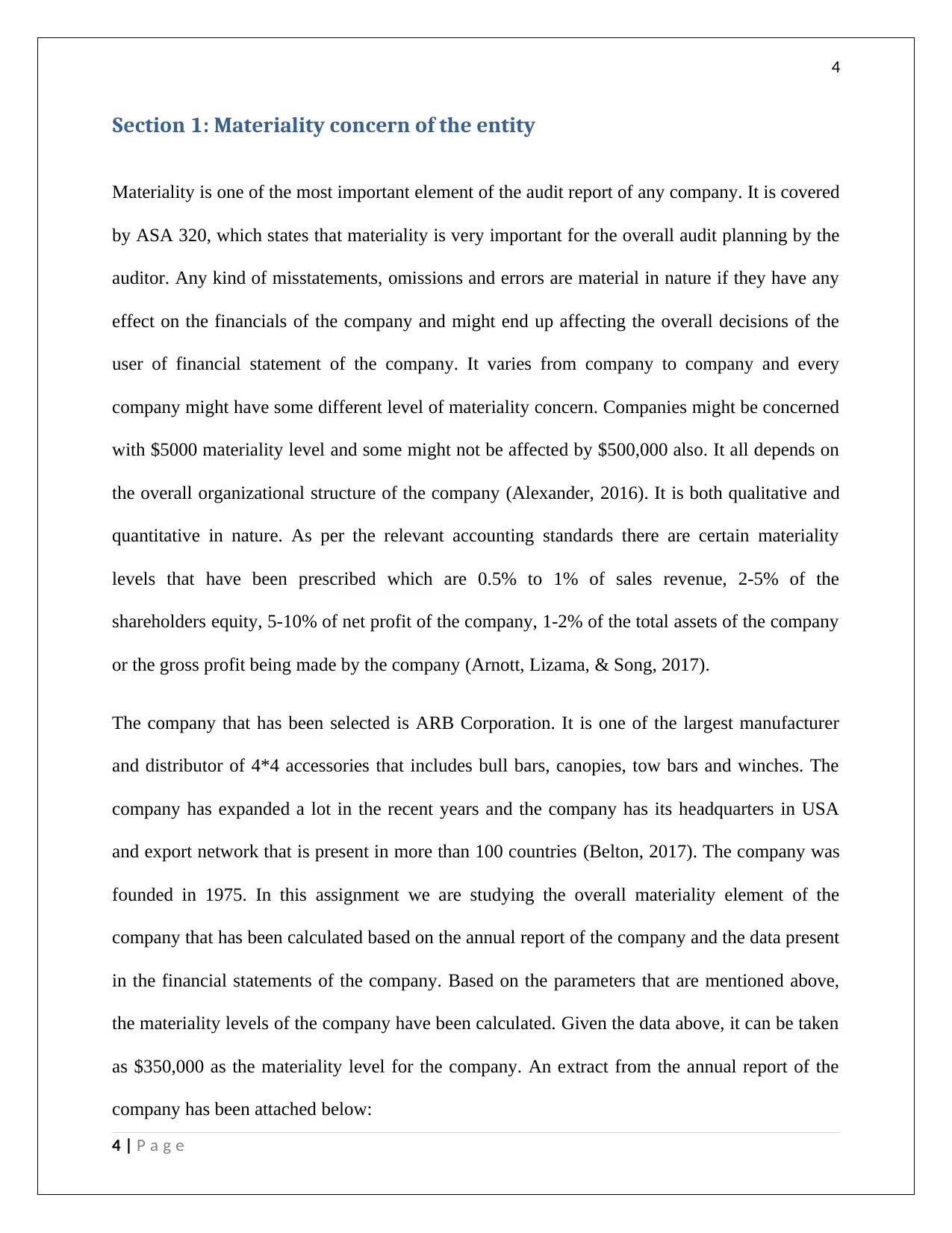
4
Section 1: Materiality concern of the entity
Materiality is one of the most important element of the audit report of any company. It is covered
by ASA 320, which states that materiality is very important for the overall audit planning by the
auditor. Any kind of misstatements, omissions and errors are material in nature if they have any
effect on the financials of the company and might end up affecting the overall decisions of the
user of financial statement of the company. It varies from company to company and every
company might have some different level of materiality concern. Companies might be concerned
with $5000 materiality level and some might not be affected by $500,000 also. It all depends on
the overall organizational structure of the company (Alexander, 2016). It is both qualitative and
quantitative in nature. As per the relevant accounting standards there are certain materiality
levels that have been prescribed which are 0.5% to 1% of sales revenue, 2-5% of the
shareholders equity, 5-10% of net profit of the company, 1-2% of the total assets of the company
or the gross profit being made by the company (Arnott, Lizama, & Song, 2017).
The company that has been selected is ARB Corporation. It is one of the largest manufacturer
and distributor of 4*4 accessories that includes bull bars, canopies, tow bars and winches. The
company has expanded a lot in the recent years and the company has its headquarters in USA
and export network that is present in more than 100 countries (Belton, 2017). The company was
founded in 1975. In this assignment we are studying the overall materiality element of the
company that has been calculated based on the annual report of the company and the data present
in the financial statements of the company. Based on the parameters that are mentioned above,
the materiality levels of the company have been calculated. Given the data above, it can be taken
as $350,000 as the materiality level for the company. An extract from the annual report of the
company has been attached below:
4 | P a g e
Section 1: Materiality concern of the entity
Materiality is one of the most important element of the audit report of any company. It is covered
by ASA 320, which states that materiality is very important for the overall audit planning by the
auditor. Any kind of misstatements, omissions and errors are material in nature if they have any
effect on the financials of the company and might end up affecting the overall decisions of the
user of financial statement of the company. It varies from company to company and every
company might have some different level of materiality concern. Companies might be concerned
with $5000 materiality level and some might not be affected by $500,000 also. It all depends on
the overall organizational structure of the company (Alexander, 2016). It is both qualitative and
quantitative in nature. As per the relevant accounting standards there are certain materiality
levels that have been prescribed which are 0.5% to 1% of sales revenue, 2-5% of the
shareholders equity, 5-10% of net profit of the company, 1-2% of the total assets of the company
or the gross profit being made by the company (Arnott, Lizama, & Song, 2017).
The company that has been selected is ARB Corporation. It is one of the largest manufacturer
and distributor of 4*4 accessories that includes bull bars, canopies, tow bars and winches. The
company has expanded a lot in the recent years and the company has its headquarters in USA
and export network that is present in more than 100 countries (Belton, 2017). The company was
founded in 1975. In this assignment we are studying the overall materiality element of the
company that has been calculated based on the annual report of the company and the data present
in the financial statements of the company. Based on the parameters that are mentioned above,
the materiality levels of the company have been calculated. Given the data above, it can be taken
as $350,000 as the materiality level for the company. An extract from the annual report of the
company has been attached below:
4 | P a g e
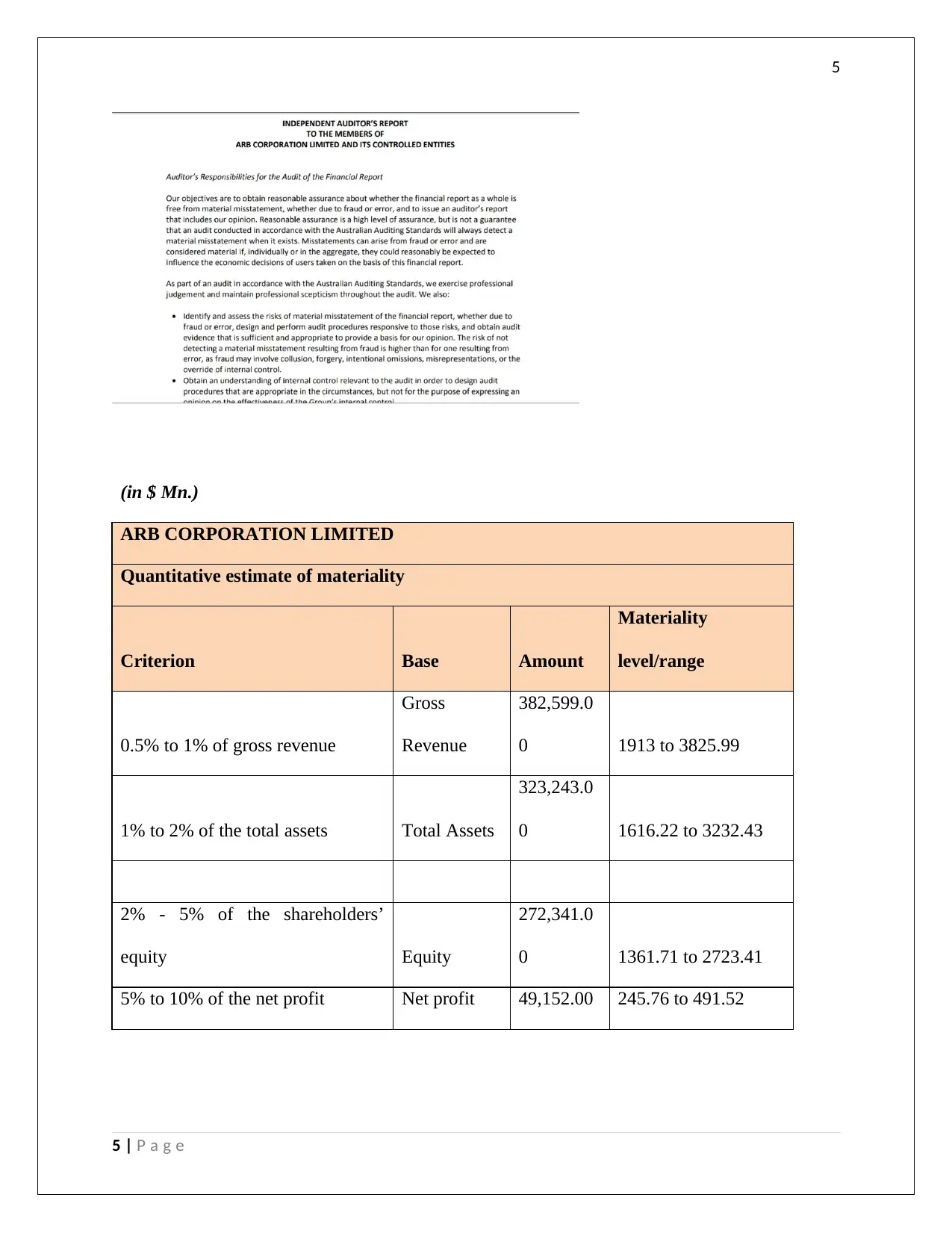
5
(in $ Mn.)
ARB CORPORATION LIMITED
Quantitative estimate of materiality
Criterion Base Amount
Materiality
level/range
0.5% to 1% of gross revenue
Gross
Revenue
382,599.0
0 1913 to 3825.99
1% to 2% of the total assets Total Assets
323,243.0
0 1616.22 to 3232.43
2% - 5% of the shareholders’
equity Equity
272,341.0
0 1361.71 to 2723.41
5% to 10% of the net profit Net profit 49,152.00 245.76 to 491.52
5 | P a g e
(in $ Mn.)
ARB CORPORATION LIMITED
Quantitative estimate of materiality
Criterion Base Amount
Materiality
level/range
0.5% to 1% of gross revenue
Gross
Revenue
382,599.0
0 1913 to 3825.99
1% to 2% of the total assets Total Assets
323,243.0
0 1616.22 to 3232.43
2% - 5% of the shareholders’
equity Equity
272,341.0
0 1361.71 to 2723.41
5% to 10% of the net profit Net profit 49,152.00 245.76 to 491.52
5 | P a g e
⊘ This is a preview!⊘
Do you want full access?
Subscribe today to unlock all pages.

Trusted by 1+ million students worldwide
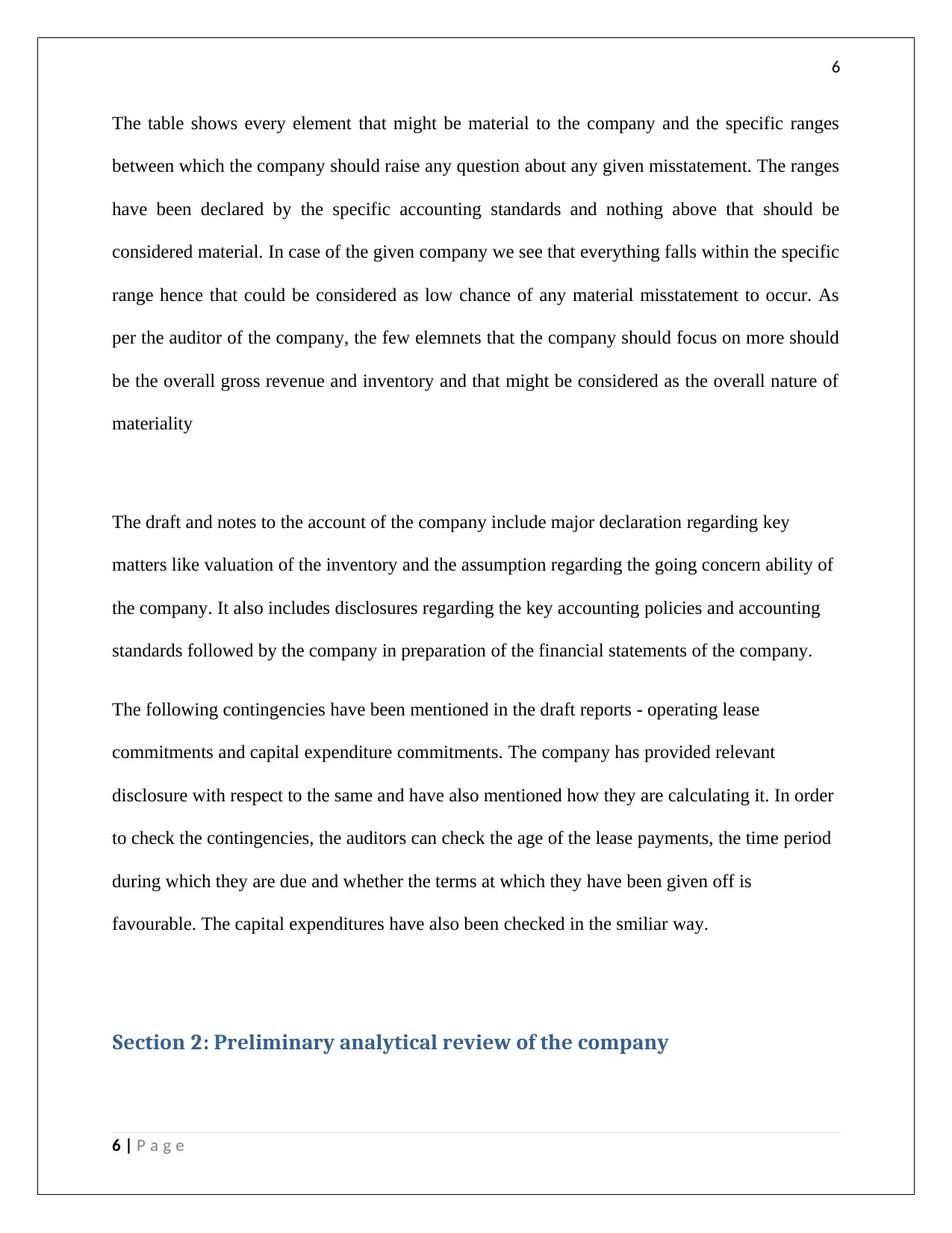
6
The table shows every element that might be material to the company and the specific ranges
between which the company should raise any question about any given misstatement. The ranges
have been declared by the specific accounting standards and nothing above that should be
considered material. In case of the given company we see that everything falls within the specific
range hence that could be considered as low chance of any material misstatement to occur. As
per the auditor of the company, the few elemnets that the company should focus on more should
be the overall gross revenue and inventory and that might be considered as the overall nature of
materiality
The draft and notes to the account of the company include major declaration regarding key
matters like valuation of the inventory and the assumption regarding the going concern ability of
the company. It also includes disclosures regarding the key accounting policies and accounting
standards followed by the company in preparation of the financial statements of the company.
The following contingencies have been mentioned in the draft reports - operating lease
commitments and capital expenditure commitments. The company has provided relevant
disclosure with respect to the same and have also mentioned how they are calculating it. In order
to check the contingencies, the auditors can check the age of the lease payments, the time period
during which they are due and whether the terms at which they have been given off is
favourable. The capital expenditures have also been checked in the smiliar way.
Section 2: Preliminary analytical review of the company
6 | P a g e
The table shows every element that might be material to the company and the specific ranges
between which the company should raise any question about any given misstatement. The ranges
have been declared by the specific accounting standards and nothing above that should be
considered material. In case of the given company we see that everything falls within the specific
range hence that could be considered as low chance of any material misstatement to occur. As
per the auditor of the company, the few elemnets that the company should focus on more should
be the overall gross revenue and inventory and that might be considered as the overall nature of
materiality
The draft and notes to the account of the company include major declaration regarding key
matters like valuation of the inventory and the assumption regarding the going concern ability of
the company. It also includes disclosures regarding the key accounting policies and accounting
standards followed by the company in preparation of the financial statements of the company.
The following contingencies have been mentioned in the draft reports - operating lease
commitments and capital expenditure commitments. The company has provided relevant
disclosure with respect to the same and have also mentioned how they are calculating it. In order
to check the contingencies, the auditors can check the age of the lease payments, the time period
during which they are due and whether the terms at which they have been given off is
favourable. The capital expenditures have also been checked in the smiliar way.
Section 2: Preliminary analytical review of the company
6 | P a g e
Paraphrase This Document
Need a fresh take? Get an instant paraphrase of this document with our AI Paraphraser
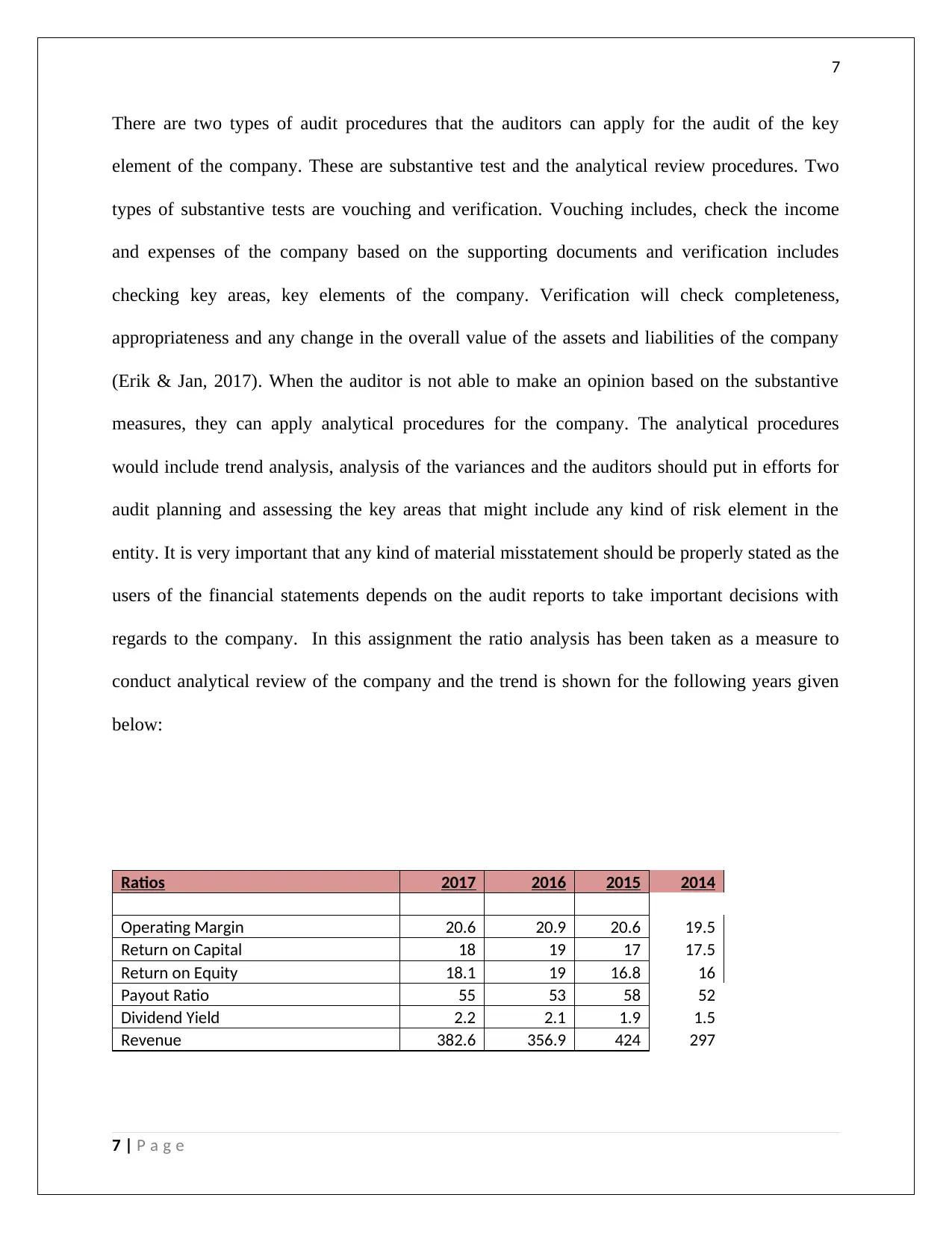
7
There are two types of audit procedures that the auditors can apply for the audit of the key
element of the company. These are substantive test and the analytical review procedures. Two
types of substantive tests are vouching and verification. Vouching includes, check the income
and expenses of the company based on the supporting documents and verification includes
checking key areas, key elements of the company. Verification will check completeness,
appropriateness and any change in the overall value of the assets and liabilities of the company
(Erik & Jan, 2017). When the auditor is not able to make an opinion based on the substantive
measures, they can apply analytical procedures for the company. The analytical procedures
would include trend analysis, analysis of the variances and the auditors should put in efforts for
audit planning and assessing the key areas that might include any kind of risk element in the
entity. It is very important that any kind of material misstatement should be properly stated as the
users of the financial statements depends on the audit reports to take important decisions with
regards to the company. In this assignment the ratio analysis has been taken as a measure to
conduct analytical review of the company and the trend is shown for the following years given
below:
Ratios 2017 2016 2015 2014
Operating Margin 20.6 20.9 20.6 19.5
Return on Capital 18 19 17 17.5
Return on Equity 18.1 19 16.8 16
Payout Ratio 55 53 58 52
Dividend Yield 2.2 2.1 1.9 1.5
Revenue 382.6 356.9 424 297
7 | P a g e
There are two types of audit procedures that the auditors can apply for the audit of the key
element of the company. These are substantive test and the analytical review procedures. Two
types of substantive tests are vouching and verification. Vouching includes, check the income
and expenses of the company based on the supporting documents and verification includes
checking key areas, key elements of the company. Verification will check completeness,
appropriateness and any change in the overall value of the assets and liabilities of the company
(Erik & Jan, 2017). When the auditor is not able to make an opinion based on the substantive
measures, they can apply analytical procedures for the company. The analytical procedures
would include trend analysis, analysis of the variances and the auditors should put in efforts for
audit planning and assessing the key areas that might include any kind of risk element in the
entity. It is very important that any kind of material misstatement should be properly stated as the
users of the financial statements depends on the audit reports to take important decisions with
regards to the company. In this assignment the ratio analysis has been taken as a measure to
conduct analytical review of the company and the trend is shown for the following years given
below:
Ratios 2017 2016 2015 2014
Operating Margin 20.6 20.9 20.6 19.5
Return on Capital 18 19 17 17.5
Return on Equity 18.1 19 16.8 16
Payout Ratio 55 53 58 52
Dividend Yield 2.2 2.1 1.9 1.5
Revenue 382.6 356.9 424 297
7 | P a g e
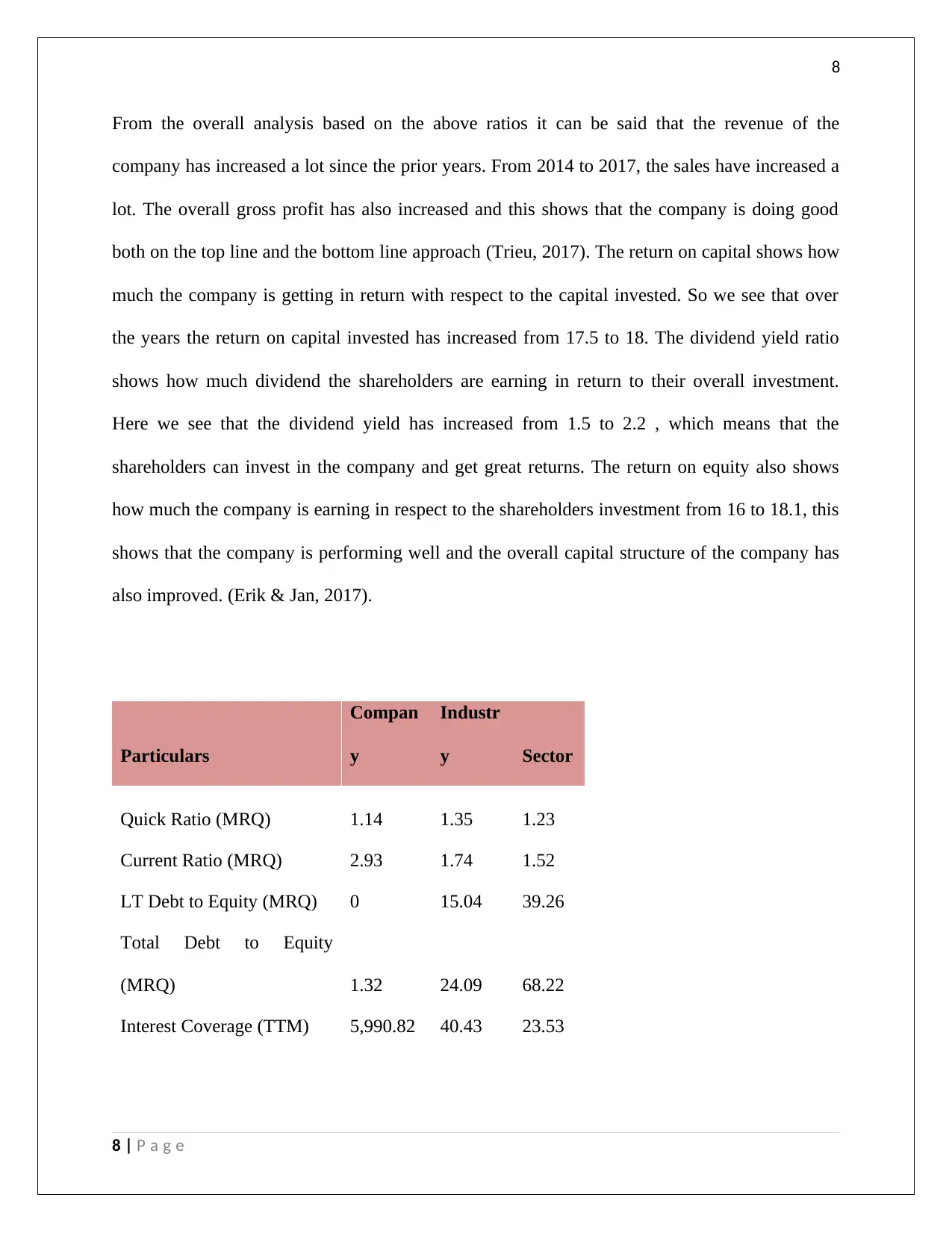
8
From the overall analysis based on the above ratios it can be said that the revenue of the
company has increased a lot since the prior years. From 2014 to 2017, the sales have increased a
lot. The overall gross profit has also increased and this shows that the company is doing good
both on the top line and the bottom line approach (Trieu, 2017). The return on capital shows how
much the company is getting in return with respect to the capital invested. So we see that over
the years the return on capital invested has increased from 17.5 to 18. The dividend yield ratio
shows how much dividend the shareholders are earning in return to their overall investment.
Here we see that the dividend yield has increased from 1.5 to 2.2 , which means that the
shareholders can invest in the company and get great returns. The return on equity also shows
how much the company is earning in respect to the shareholders investment from 16 to 18.1, this
shows that the company is performing well and the overall capital structure of the company has
also improved. (Erik & Jan, 2017).
Particulars
Compan
y
Industr
y Sector
Quick Ratio (MRQ) 1.14 1.35 1.23
Current Ratio (MRQ) 2.93 1.74 1.52
LT Debt to Equity (MRQ) 0 15.04 39.26
Total Debt to Equity
(MRQ) 1.32 24.09 68.22
Interest Coverage (TTM) 5,990.82 40.43 23.53
8 | P a g e
From the overall analysis based on the above ratios it can be said that the revenue of the
company has increased a lot since the prior years. From 2014 to 2017, the sales have increased a
lot. The overall gross profit has also increased and this shows that the company is doing good
both on the top line and the bottom line approach (Trieu, 2017). The return on capital shows how
much the company is getting in return with respect to the capital invested. So we see that over
the years the return on capital invested has increased from 17.5 to 18. The dividend yield ratio
shows how much dividend the shareholders are earning in return to their overall investment.
Here we see that the dividend yield has increased from 1.5 to 2.2 , which means that the
shareholders can invest in the company and get great returns. The return on equity also shows
how much the company is earning in respect to the shareholders investment from 16 to 18.1, this
shows that the company is performing well and the overall capital structure of the company has
also improved. (Erik & Jan, 2017).
Particulars
Compan
y
Industr
y Sector
Quick Ratio (MRQ) 1.14 1.35 1.23
Current Ratio (MRQ) 2.93 1.74 1.52
LT Debt to Equity (MRQ) 0 15.04 39.26
Total Debt to Equity
(MRQ) 1.32 24.09 68.22
Interest Coverage (TTM) 5,990.82 40.43 23.53
8 | P a g e
⊘ This is a preview!⊘
Do you want full access?
Subscribe today to unlock all pages.

Trusted by 1+ million students worldwide
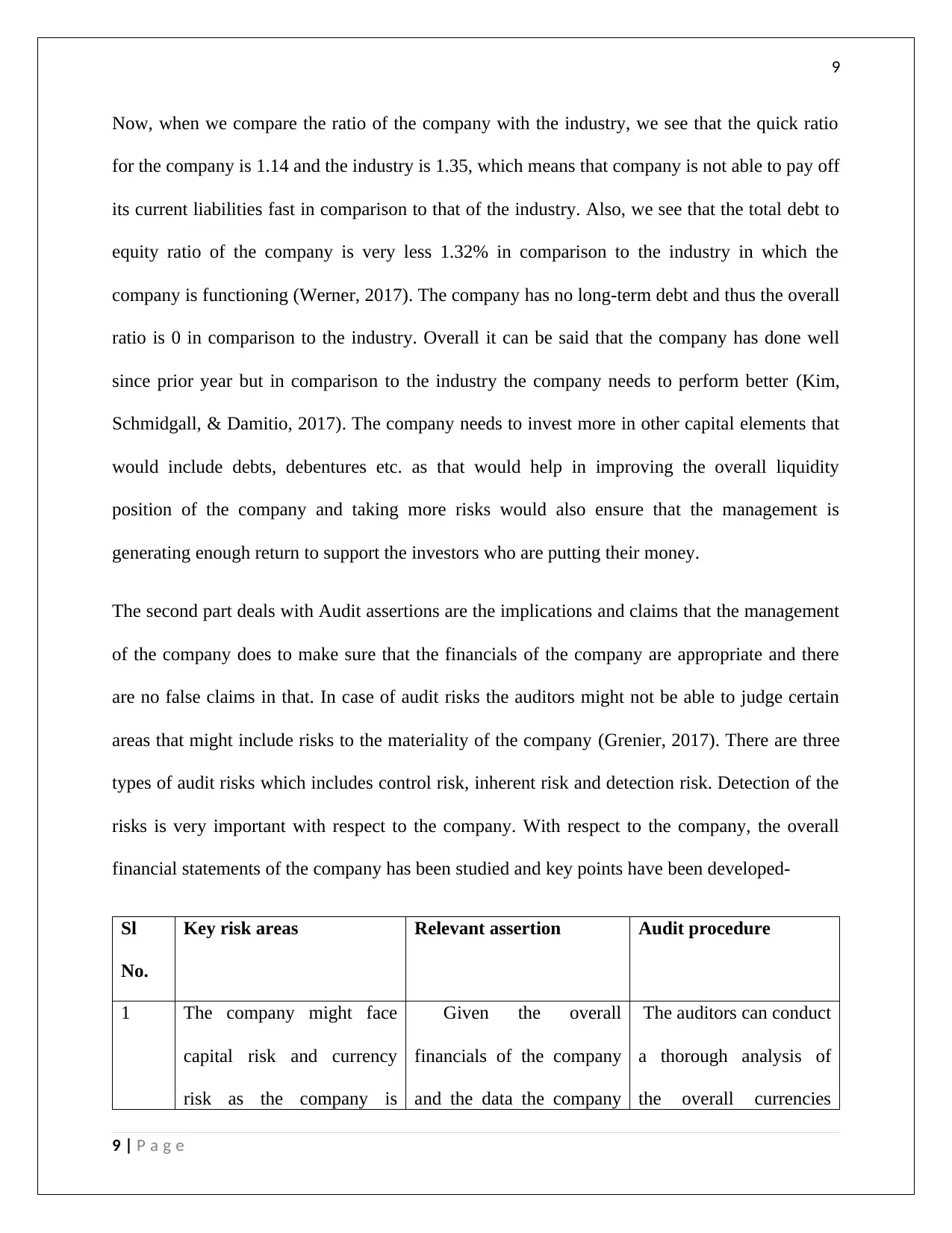
9
Now, when we compare the ratio of the company with the industry, we see that the quick ratio
for the company is 1.14 and the industry is 1.35, which means that company is not able to pay off
its current liabilities fast in comparison to that of the industry. Also, we see that the total debt to
equity ratio of the company is very less 1.32% in comparison to the industry in which the
company is functioning (Werner, 2017). The company has no long-term debt and thus the overall
ratio is 0 in comparison to the industry. Overall it can be said that the company has done well
since prior year but in comparison to the industry the company needs to perform better (Kim,
Schmidgall, & Damitio, 2017). The company needs to invest more in other capital elements that
would include debts, debentures etc. as that would help in improving the overall liquidity
position of the company and taking more risks would also ensure that the management is
generating enough return to support the investors who are putting their money.
The second part deals with Audit assertions are the implications and claims that the management
of the company does to make sure that the financials of the company are appropriate and there
are no false claims in that. In case of audit risks the auditors might not be able to judge certain
areas that might include risks to the materiality of the company (Grenier, 2017). There are three
types of audit risks which includes control risk, inherent risk and detection risk. Detection of the
risks is very important with respect to the company. With respect to the company, the overall
financial statements of the company has been studied and key points have been developed-
Sl
No.
Key risk areas Relevant assertion Audit procedure
1 The company might face
capital risk and currency
risk as the company is
Given the overall
financials of the company
and the data the company
The auditors can conduct
a thorough analysis of
the overall currencies
9 | P a g e
Now, when we compare the ratio of the company with the industry, we see that the quick ratio
for the company is 1.14 and the industry is 1.35, which means that company is not able to pay off
its current liabilities fast in comparison to that of the industry. Also, we see that the total debt to
equity ratio of the company is very less 1.32% in comparison to the industry in which the
company is functioning (Werner, 2017). The company has no long-term debt and thus the overall
ratio is 0 in comparison to the industry. Overall it can be said that the company has done well
since prior year but in comparison to the industry the company needs to perform better (Kim,
Schmidgall, & Damitio, 2017). The company needs to invest more in other capital elements that
would include debts, debentures etc. as that would help in improving the overall liquidity
position of the company and taking more risks would also ensure that the management is
generating enough return to support the investors who are putting their money.
The second part deals with Audit assertions are the implications and claims that the management
of the company does to make sure that the financials of the company are appropriate and there
are no false claims in that. In case of audit risks the auditors might not be able to judge certain
areas that might include risks to the materiality of the company (Grenier, 2017). There are three
types of audit risks which includes control risk, inherent risk and detection risk. Detection of the
risks is very important with respect to the company. With respect to the company, the overall
financial statements of the company has been studied and key points have been developed-
Sl
No.
Key risk areas Relevant assertion Audit procedure
1 The company might face
capital risk and currency
risk as the company is
Given the overall
financials of the company
and the data the company
The auditors can conduct
a thorough analysis of
the overall currencies
9 | P a g e
Paraphrase This Document
Need a fresh take? Get an instant paraphrase of this document with our AI Paraphraser
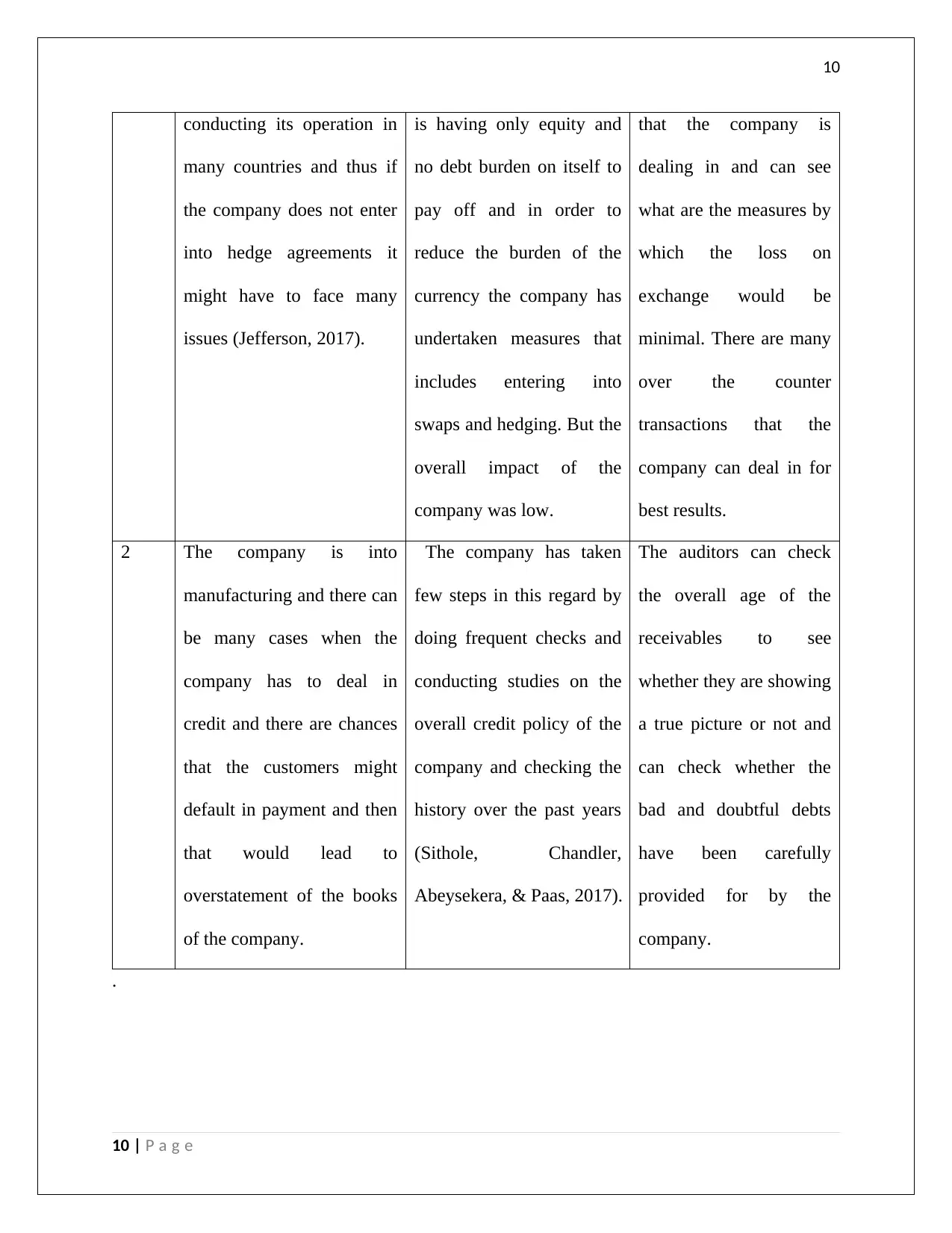
10
conducting its operation in
many countries and thus if
the company does not enter
into hedge agreements it
might have to face many
issues (Jefferson, 2017).
is having only equity and
no debt burden on itself to
pay off and in order to
reduce the burden of the
currency the company has
undertaken measures that
includes entering into
swaps and hedging. But the
overall impact of the
company was low.
that the company is
dealing in and can see
what are the measures by
which the loss on
exchange would be
minimal. There are many
over the counter
transactions that the
company can deal in for
best results.
2 The company is into
manufacturing and there can
be many cases when the
company has to deal in
credit and there are chances
that the customers might
default in payment and then
that would lead to
overstatement of the books
of the company.
The company has taken
few steps in this regard by
doing frequent checks and
conducting studies on the
overall credit policy of the
company and checking the
history over the past years
(Sithole, Chandler,
Abeysekera, & Paas, 2017).
The auditors can check
the overall age of the
receivables to see
whether they are showing
a true picture or not and
can check whether the
bad and doubtful debts
have been carefully
provided for by the
company.
.
10 | P a g e
conducting its operation in
many countries and thus if
the company does not enter
into hedge agreements it
might have to face many
issues (Jefferson, 2017).
is having only equity and
no debt burden on itself to
pay off and in order to
reduce the burden of the
currency the company has
undertaken measures that
includes entering into
swaps and hedging. But the
overall impact of the
company was low.
that the company is
dealing in and can see
what are the measures by
which the loss on
exchange would be
minimal. There are many
over the counter
transactions that the
company can deal in for
best results.
2 The company is into
manufacturing and there can
be many cases when the
company has to deal in
credit and there are chances
that the customers might
default in payment and then
that would lead to
overstatement of the books
of the company.
The company has taken
few steps in this regard by
doing frequent checks and
conducting studies on the
overall credit policy of the
company and checking the
history over the past years
(Sithole, Chandler,
Abeysekera, & Paas, 2017).
The auditors can check
the overall age of the
receivables to see
whether they are showing
a true picture or not and
can check whether the
bad and doubtful debts
have been carefully
provided for by the
company.
.
10 | P a g e
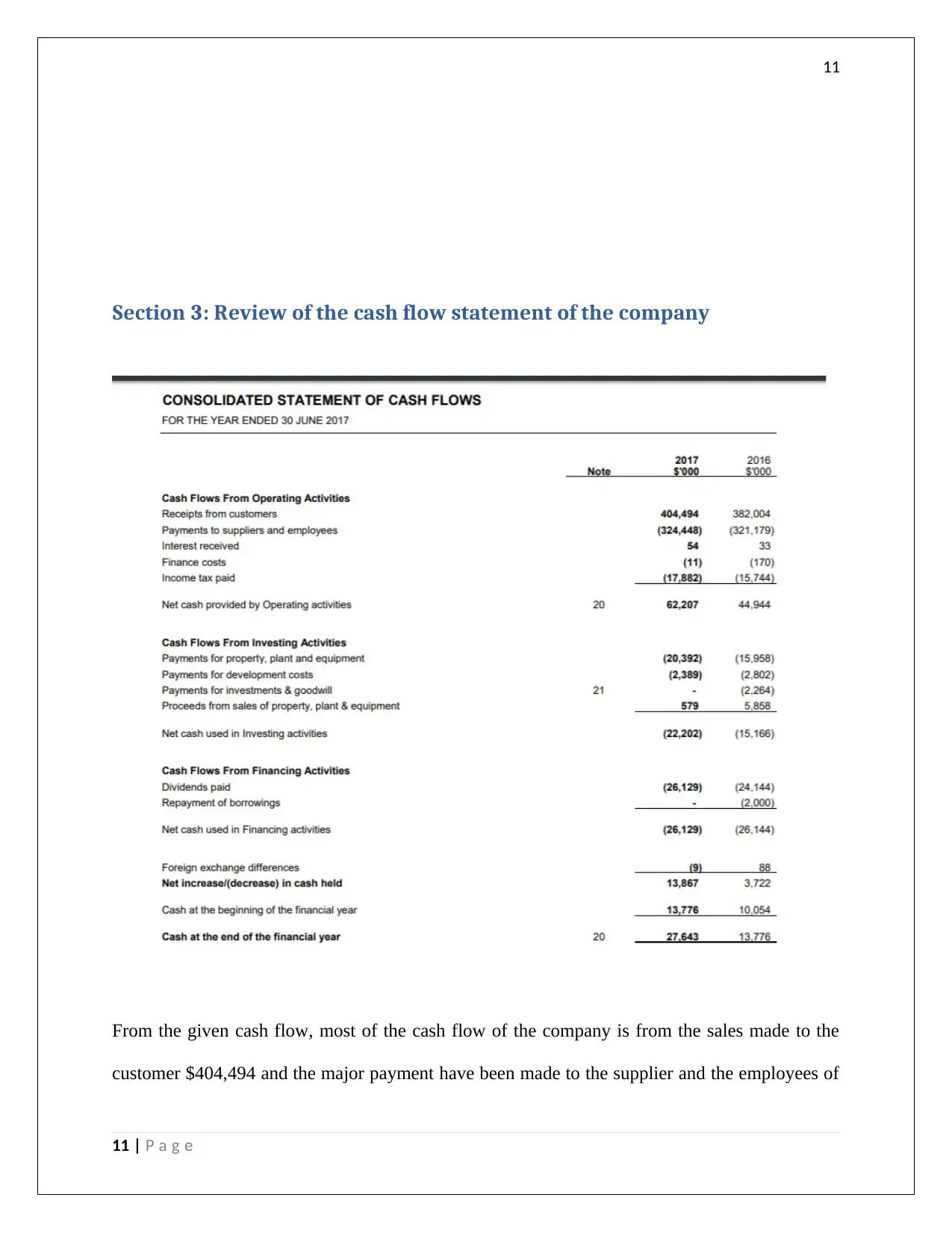
11
Section 3: Review of the cash flow statement of the company
From the given cash flow, most of the cash flow of the company is from the sales made to the
customer $404,494 and the major payment have been made to the supplier and the employees of
11 | P a g e
Section 3: Review of the cash flow statement of the company
From the given cash flow, most of the cash flow of the company is from the sales made to the
customer $404,494 and the major payment have been made to the supplier and the employees of
11 | P a g e
⊘ This is a preview!⊘
Do you want full access?
Subscribe today to unlock all pages.

Trusted by 1+ million students worldwide
1 out of 16
Related Documents
Your All-in-One AI-Powered Toolkit for Academic Success.
+13062052269
info@desklib.com
Available 24*7 on WhatsApp / Email
![[object Object]](/_next/static/media/star-bottom.7253800d.svg)
Unlock your academic potential
Copyright © 2020–2025 A2Z Services. All Rights Reserved. Developed and managed by ZUCOL.





